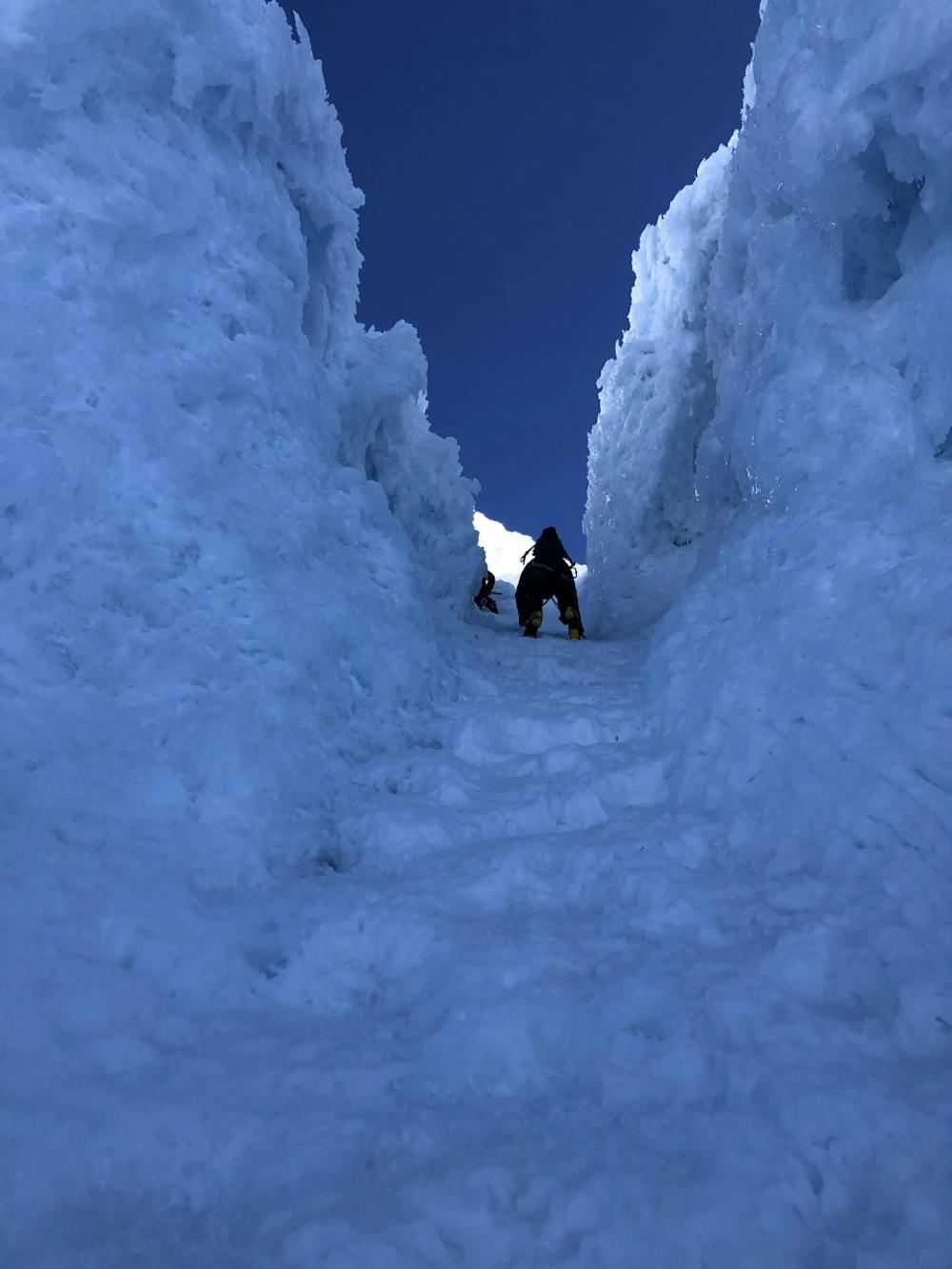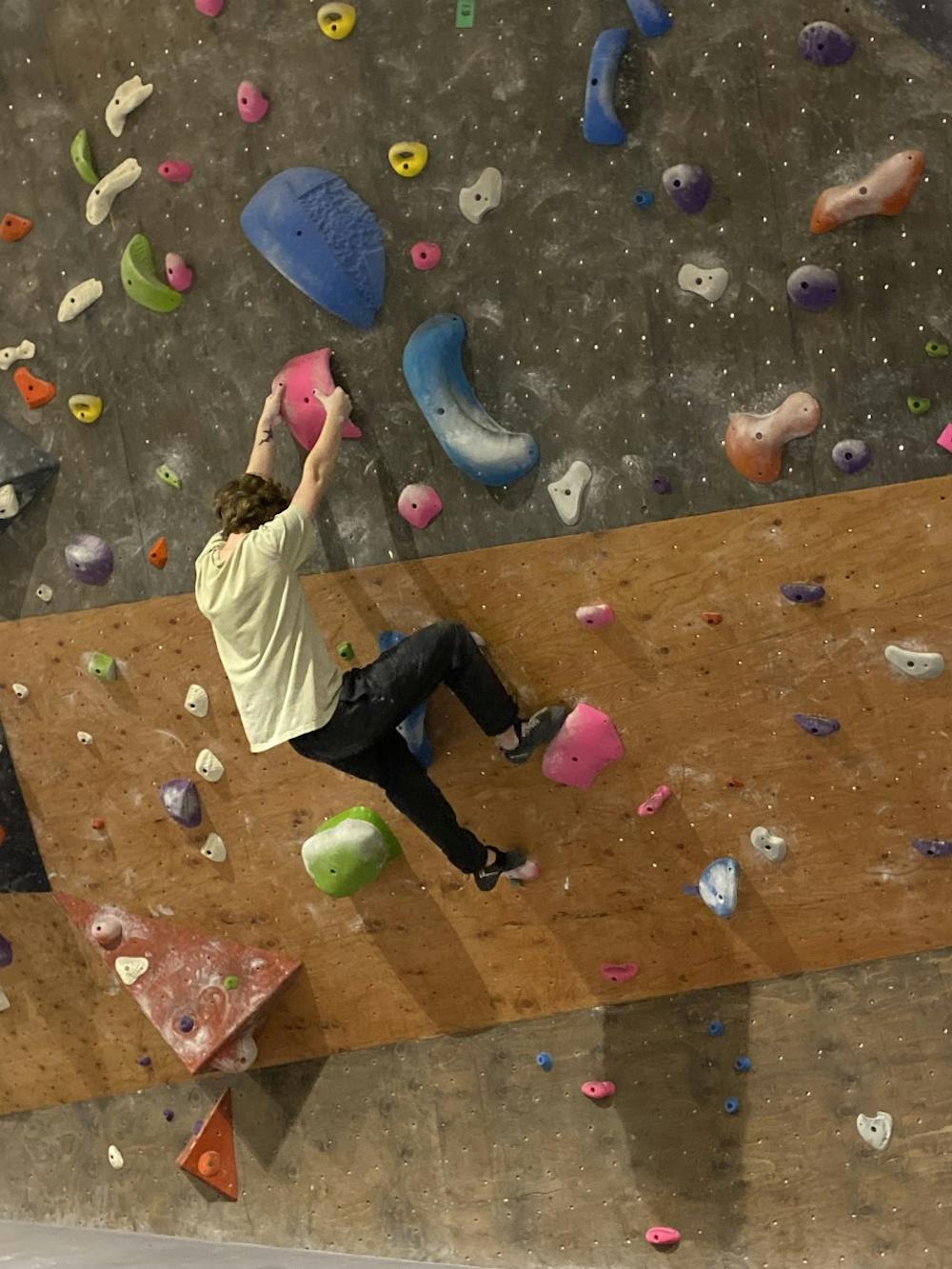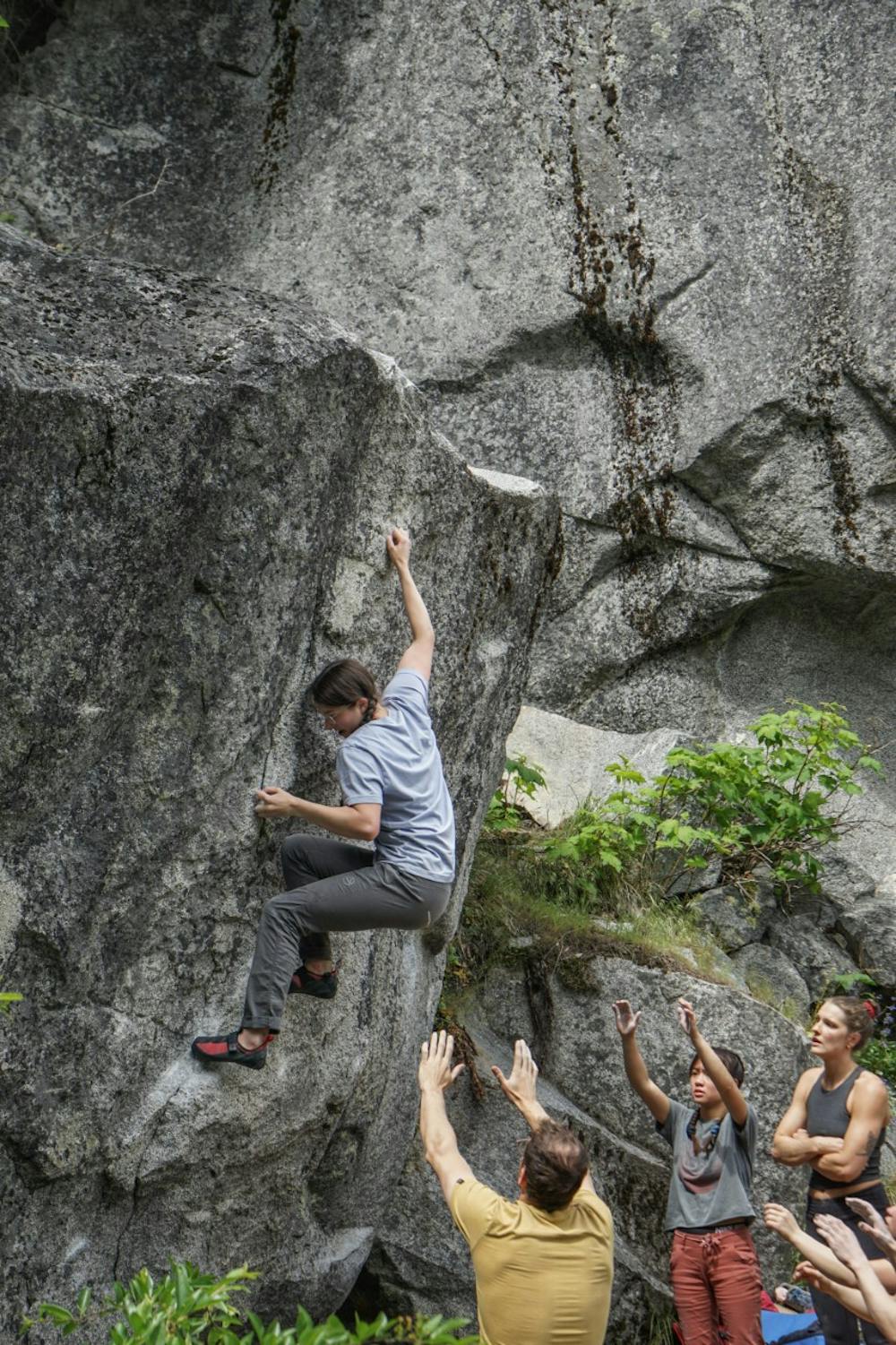Fingertips searching for a stable hold on the textured basalt, forearms cramping from the strain. As my body clings to the skeleton of a caldera, all I can think about is the sky. The updraft from the valley below carries the bubbling of familiar laughter and out of my peripheral vision, I see a prairie falcon riding the same gust of wind. I can’t help but think that this is the closest I will ever get to experiencing the world as it does. This is why I climb.
The form of matter is trivial; snow, rock, scree — vertical or horizontal — is the least important part. I love the way my crampons bite into the packed ice sheets of the Cascades and having an ice ax as a rudder, helping to steer the trajectory of my body accelerating down an ice chute. The rush of adrenaline that comes from balancing on the exposed ledge of Longs Peak’s narrows, a necessary obstacle on the homestretch towards the summit. The feeling of every fiber of my being resonating with energy as I reach for the final hold on a route at ozone. Each form of climbing offers its own challenges, its own rewards. How could I ever choose a favorite?
This wasn’t always my perspective.
Like all relationships, mine with climbing is complex. It was less of an instant soul connection and more of a slow burn. I first discovered climbing through others. I would go to the gym with my friends, climb a few routes, become extremely frustrated with the steep learning curve and leave in a worsened mood. I climbed because others wanted me to, not because I had a desire to climb myself.
Things were not off to a great start. But piece by piece and hold by hold, things started coming together.

Photo courtesy of Ellie Black
I summited Mount St. Helens with one of my close friends this last semester and was reminded of the 14,000-foot peaks I had left back home in Colorado. My reminiscing was quickly replaced by a desire to summit more peaks throughout the Cascades, an entirely different beast than the Rockies — but one I was excited to get to know.
A few weeks later I went on my first outdoor rock climbing trip to Smith Rock with Women on the Wall, an Outdoor Pursuits Program that creates trips for women, led by women. Grasping the basalt, still cool from the shade, I made it up my first route,and then my second. And on my third, I was lead climbing. I completed the route through the encouragement from badass climbers, all women.
This is why I climb.

Photo courtesy of Ellie Black
Climbing has allowed me to develop in my individuality. I get to summit mountains in solitude, relishing in the sacred time set aside for self-reflection and development of my connection to the natural world. While bouldering for hours at Portland Rock Gym, my mind settles into a meditative state as I climb routes that speak to me. Finally, climbing for myself.
Embracing the stillness of your surroundings, and sinking into the grind of the climb is what brought senior Nick Paciulla into the world of climbing.

Photo courtesy of Nick Paciulla
“You can be on the side of a mountain and no one else is there,” Paciulla said. “Especially at night, when there’s no clouds, no wind. You’re just hiking up and it’s you and the snow and your partner. That’s pretty awesome.”
If you are accompanied by a partner or two, competition never has to be a part of your climb. The success of your climb is determined by whatever parameters you set for yourself. Spending a day in the sun, enjoying the company of your fellow climbers, can be successful. Sending a new grade or developing a technical skill can be successful. The satisfaction of the send is not simply dependent on making it to the top of a route.
“It’s not like you’re competing against anyone,” Paciulla said. “It’s just you climbing. It’s up to you, how you want to push yourself.”
The act of caring for yourself, fully pursuing what brings you joy and leaning into that love is infectious. I have witnessed this in both myself and in others. It carries over into every other facet of your life and offers opportunities for growth and challenge.
The spirituality of the send is one of the biggest draws to climbing and sophomore Evan Putzke agrees. Putzke sent his first bouldering route at the climbing wall in Beauchamp last October, and has been scrambling up rock ever since.
But for him, climbing is more than just a way to get a workout in between classes. It’s a way to connect to the people around him, challenge himself individually, and experience the feeling of total liberation while on the wall.
“Climbing, it’s like dance, or like running,” Putzke said. “It is a very pure and human form of sport.”
There seems to be a universal call to scale the awesome landforms around us. This is evident through the history of climbing, with cultures all over the earth pioneering rock faces, summiting peaks and seeking the addictive rush of fully and truly experiencing the climb. Observing what is above, in order to bring that learned wisdom back down to the world below.

Photo courtesy of Evan Putzke
“Where there are mountains, where there’s rock, people are going to climb,” Putzke said. “It’s very ingrained into being human, it goes beyond the actual physical act of climbing. It’s very spiritual.”
Accompanying this spiritual exploration, is the opportunity to continue to grow and develop, as both a climber and as a person.
“You never reach a point where you are like this is it,” Putzke said. “You can always improve your technique or your strength or your mental climbing game, it’s something you can always work on.”
And this self improvement is a perpetuating cycle that quite literally, never has to end. The fluidity of the movements and low intensity nature of climbing, means that it is a sport sustainable late into life. There are 70 year olds out there scaling monstrous faces — send it to the grave baby.
Now the aim of climbing becomes sharing this exuberance for life, this stoke for trying new things with others. Being the earthbound support for those first experiencing the rush of climbing on rock.
Climber Mim Fox has been this support system for newbies for a little while now. After climbing competitively for 10 years, she has taken a step back from the high stakes of the competitive arena, working as both a coach and mentor at her home gym and at UP.
One of her favorite parts about climbing is the aspect of community and support. She aims to introduce more people into the world she has loved since she was 11, providing tips on technique and helping facilitate that first positive experience with the outdoors.
“To see people rope climbing for the first time outside, lead climbing for the first time outside, it is so cool to see that spark,” Fox said.

Photo courtesy of Mim Fox
Fox’s experience in the competitive world has provided her with perspectives on the sport very different from my own. At the competitive level, your whole life revolves around climbing, because it has to. Tunnel vision sets in and the outside world blurs away. With your sights set on the next competition, every focus is on what steps must be taken in order to win.
“Something that one of my coaches told me that was really important, was that the pressure you experience in climbing is a privilege,” Fox said. “You are able to put yourself in difficult scenarios and lots of people do not have the opportunity to test themselves or challenge themselves in that way mentally and physically.”
In a sport where you are falling and failing more than you are succeeding, mental resilience is key.
Taking a hiatus from the competitive world, Fox has begun focusing her energy on making time for other things that she loves, such as skiing and spending time with her family. She has begun climbing simply for herself again — pushing the limits of her physical ability while further connecting to fellow climbers.
“UP offers a really cool and unique opportunity for people who want to try climbing because you can just walk in, and you don’t have to rent shoes, there’s less of a financial barrier to get into it,” Fox said. “Because like a lot of sports, it can be expensive.”
Organizations like Women on the Wall or Climbing4Change are steps in the right direction when fostering inclusivity and openness within the world of climbing. Within the United States, the sport has historically been dominated by white men. These safe spaces are a necessity and are long overdue.
But even with financial barriers removed, climbing can still be daunting to pick up. Knowledge is required for one’s safety and you often must climb with a partner. If you have no previous exposure to the outdoors, to climbing, hiking or glissading, it can seem impossible to even find a place to start.
But now is the time to take that first leap. Take advantage of the resources at UP. Climb at Beauchamp, sign up for Outdoor Pursuits trips, reach out to those around you who are involved with climbing and get outside. I promise there is a place for you. I’ll see you out there :)
Ellie Black is a reporter for The Beacon. She can be reached at blacke24@up.edu.








